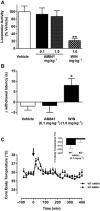AM841, a covalent cannabinoid ligand, powerfully slows gastrointestinal motility in normal and stressed mice in a peripherally restricted manner
- PMID: 25572435
- PMCID: PMC4403103
- DOI: 10.1111/bph.13069
AM841, a covalent cannabinoid ligand, powerfully slows gastrointestinal motility in normal and stressed mice in a peripherally restricted manner
Abstract
Background and purpose: Cannabinoid (CB) ligands have been demonstrated to have utility as novel therapeutic agents for the treatment of pain, metabolic conditions and gastrointestinal (GI) disorders. However, many of these ligands are centrally active, which limits their usefulness. Here, we examine a unique novel covalent CB receptor ligand, AM841, to assess its potential for use in physiological and pathophysiological in vivo studies.
Experimental approach: The covalent nature of AM841 was determined in vitro using electrophysiological and receptor internalization studies on isolated cultured hippocampal neurons. Mouse models were used for behavioural analysis of analgesia, hypothermia and hypolocomotion. The motility of the small and large intestine was assessed in vivo under normal conditions and after acute stress. The brain penetration of AM841 was also determined.
Key results: AM841 behaved as an irreversible CB1 receptor agonist in vitro. AM841 potently reduced GI motility through an action on CB1 receptors in the small and large intestine under physiological conditions. AM841 was even more potent under conditions of acute stress and was shown to normalize accelerated GI motility under these conditions. This compound behaved as a peripherally restricted ligand, showing very little brain penetration and no characteristic centrally mediated CB1 receptor-mediated effects (analgesia, hypothermia or hypolocomotion).
Conclusions and implications: AM841, a novel peripherally restricted covalent CB1 receptor ligand that was shown to be remarkably potent, represents a new class of potential therapeutic agents for the treatment of functional GI disorders.
© 2015 The British Pharmacological Society.
Figures






References
-
- Abalo R, Vera G, Lopez-Perez AE, Martinez-Villaluenga M, Martin-Fontelles MI. The gastrointestinal pharmacology of cannabinoids: focus on motility. Pharmacology. 2012;90:1–10. - PubMed
-
- Adam JM, Clark JK, Davies K, Everett K, Fields R, Francis S, et al. Low brain penetrant CB1 receptor agonists for the treatment of neuropathic pain. Bioorg Med Chem Lett. 2012;22:2932–2937. - PubMed
-
- Aviello G, Romano B, Izzo AA. Cannabinoids and gastrointestinal motility: animal and human studies. Eur Rev Med Pharmacol Sci. 2008;12(Suppl. 1):81–93. - PubMed
Publication types
MeSH terms
Substances
Grants and funding
LinkOut - more resources
Full Text Sources
Other Literature Sources
Medical

